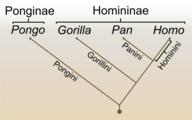Subject

photo credits: Wikimedia Commons
Human evolution is the evolutionary process within the history of primates that led to the emergence of Homo sapiens as a distinct species of the hominid family, which includes all the great apes. This process involved the gradual development of traits such as human bipedalism, dexterity and complex language, as well as interbreeding with other hominins (a tribe of the African hominid subfamily), indicating that human evolution was not linear but weblike. The study of the origins of humans, also called anthropogeny, anthropogenesis, or anthropogony, involves several scientific disciplines, including physical and evolutionary anthropology, paleontology, and genetics.Primates diverged from other mammals about 85 million years ago (mya), in the Late Cretaceous period, with their earliest fossils appearing over 55 mya, during the Paleocene. Primates produced successive clades leading to the ape superfamily, which gave rise to the hominid and the gibbon families; these diverged some 15–20 mya. African and Asian hominids (including orangutans) diverged about 14 mya. Hominins (including the Australopithecine and Panina subtribes) parted from the Gorillini tribe (gorillas) between 8–9 mya; Australopithecine (including the extinct biped ancestors of humans) separated from the Pan genus (containing chimpanzees and bonobos) 4–7 mya. The Homo genus is evidenced by the appearance of H. habilis over 2 mya, while anatomically modern humans emerged in Africa approximately 300,000 years ago. Source: Wikipedia (en)
Works about human evolution 19
How Religion Evolved and Why It Endures
-
Min europeiska familj: De senaste 54 000 åren
A Troublesome Inheritance
-
Last Ape Standing: The Seven-Million-Year Story of How and Why We Survived
-
The Faith Instinct
Before the Dawn
-
The Real Eve
-
The Runaway Brain: The Evolution of Human Uniqueness
The Third Chimpanzee
-
Origins
The Dragons of Eden: Speculations on the Evolution of Human Intelligence
-
Human origins : Louis Leakey and the East African evidence / eds. Glynn Llywelyn Isaac, Elizabeth R. McCown
-
Humankind emerging / eds. Bernard Grant Campbell
-
The Hunting Hypothesis
The Social Contract
-
The Immense Journey
Before Adam
The Descent of Man, and Selection in Relation to Sex

Man's Place in Nature
Subject - wd:Q83944







